Whispers of Wisdom: Design Your Own Tranquil Buddha Garden, No Matter the Size
Have you ever felt overwhelmed by life’s endless rush, wishing you could press pause just for a moment in a space where the noise of the world fades away? Finding that sanctuary doesn’t require a secluded retreat or a hefty investment. The answer lies in your own backyard, balcony, or even a sun-drenched corner – in the mindful creation of a personal Buddha garden.
A Buddha garden is more than just pretty plants and decorations. It is a space created for contemplation. It is for mindfulness, and a deeper connection to nature. A personal sanctuary where you can find a moment of peace amidst a busy day. And the best part? Creating your personal garden isn’t complicated. It just needs intention, a bit of creativity, and your personal touch. Even a small corner of your balcony or yard can become a spot where worries fade, replaced by a sense of peace.
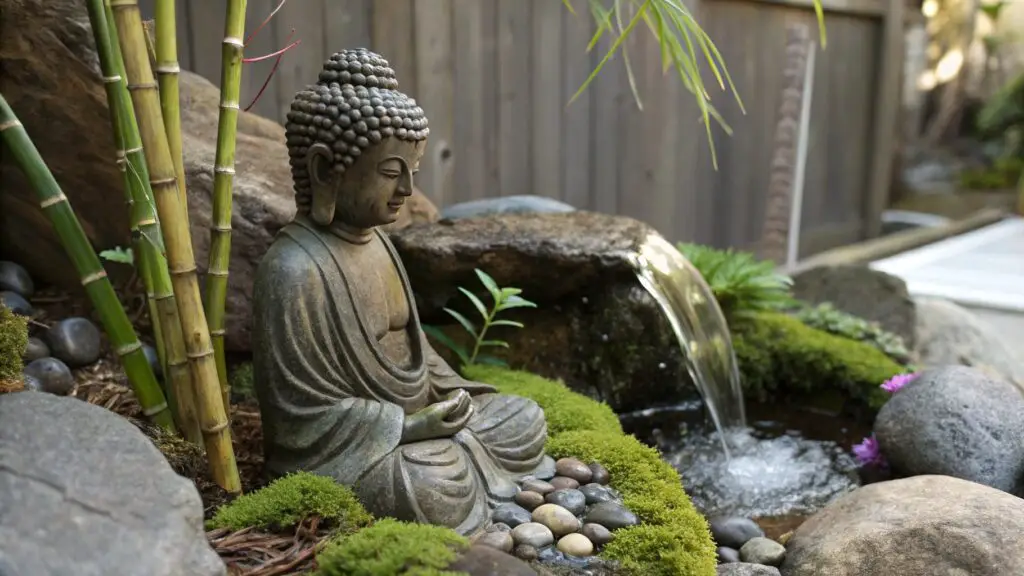
Below we will look at the core ideas behind a Buddha garden, how to select meaningful elements, and practical tips to fit your unique space. From backyard gardens to balcony nooks and even indoor corners, you’ll find ideas that inspire and work for your home. Ready to transform your space into a calming retreat?
The Essence and Core Principles of a Buddha Garden
Creating a Buddha garden isn’t about just placing statues and plants. It’s about understanding what truly makes a space peaceful and meaningful. The principles of Buddha gardens help guide this process.
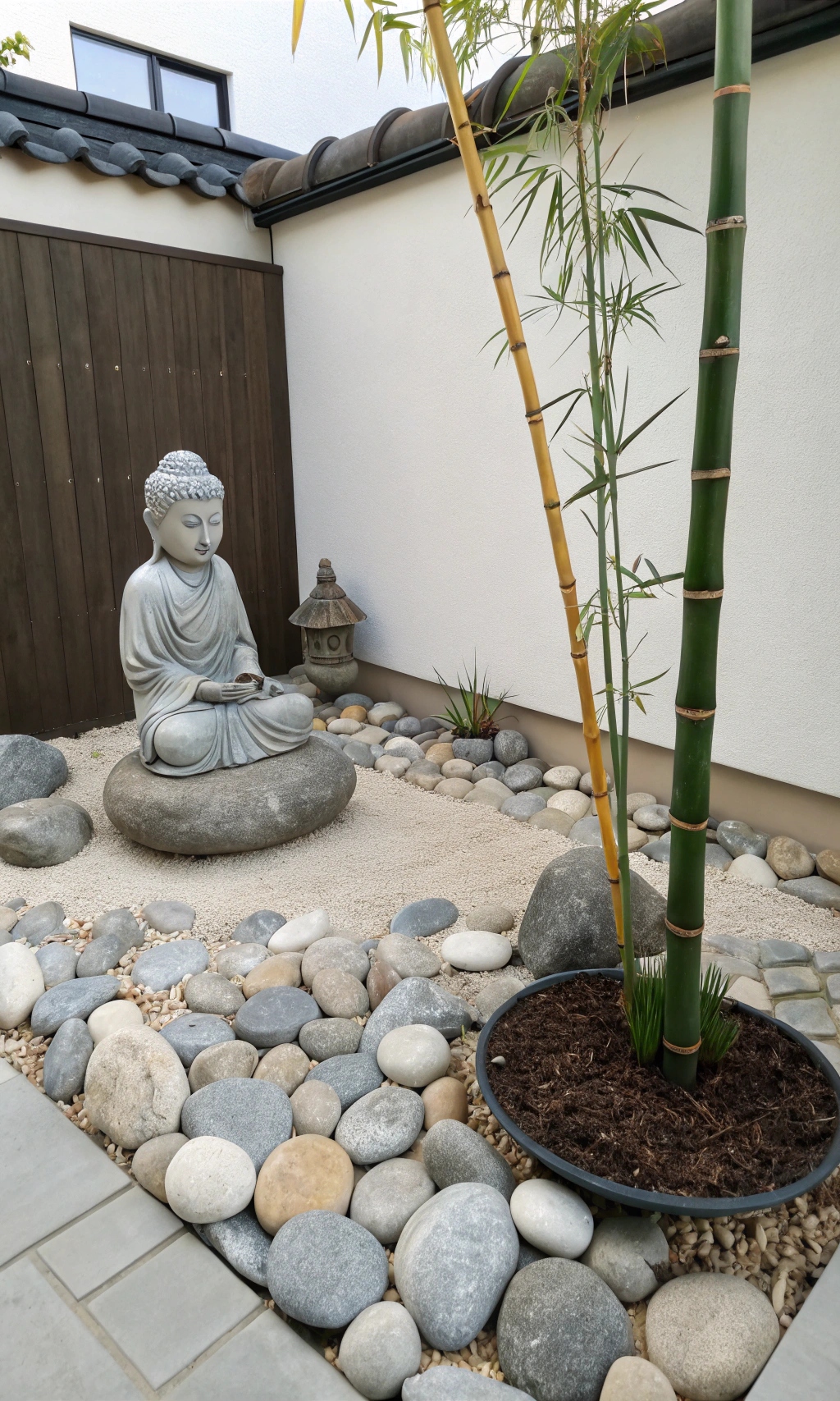
Spirituality over Decoration
At its heart, a Buddha garden is about intention, not decoration. It’s less about following strict rules or guidelines and more about creating a feeling of calm and mindfulness. You’re not trying to impress others with an elaborate design. Instead, your goal is creating a space where you can find peace and clarity.
Simplicity and Minimalism
The Buddha taught about non-attachment, which means not clinging to things. A Buddha garden follows this idea with a simple, uncluttered design. The fewer things you have, the easier it is to focus on what matters. Too many decorations or plants can distract you. Keep your garden simple—every item should have a clear purpose.
Nature as Teacher
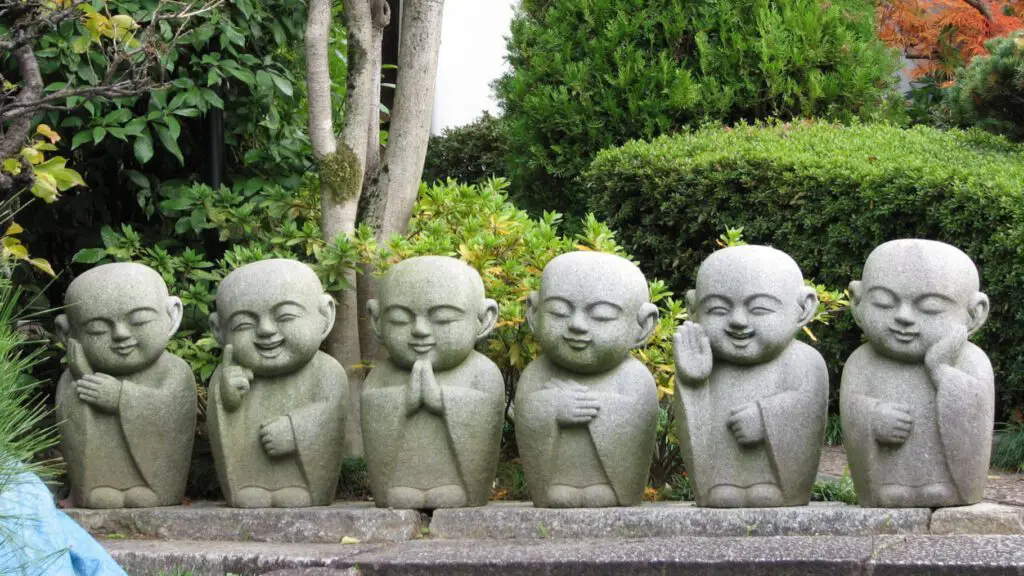
Nature teaches calmness, acceptance, and balance. A Buddha garden connects deeply with nature’s simplicity. Using natural materials like stone, wood, plants, and water helps create a peaceful atmosphere. Nature moves slowly and patiently. When your garden reflects these qualities, it encourages you to slow down, too.
Harmony and Balance
The concept of Yin and Yang guides many garden designs. It represents balance between opposite elements—like hard and soft, dark and light, stillness and movement. To achieve harmony, your garden should blend these contrasts gently. For example, smooth stones alongside soft moss, or the sound of flowing water next to silent statues. This balance brings calm energy to your space.
Personal Connection
Every Buddha garden should reflect you and your journey. The statues, plants, and layout should resonate personally. Choose elements that speak to you deeply, like plants you love or a statue that makes you feel peaceful. When your garden feels personal, it becomes a meaningful space you’ll return to often.
Mini Monk Buddha Statue
Three mini monk Buddha statues carved from eco-friendly green sandstone bring artistic flair and lasting strength to any setting. Their endearing poses and Chinese-inspired symbolism fill desks, gardens, tea tables, and offices with calming energy and spark conversation. Perfect for meditation corners or as memorable gifts.
Add serenity anywhere with this set of four little monk sandstone sculptures. Durable natural sandstone makes each pose—‘hear no evil, see no evil, speak no evil, move no evil’—vibrant and long-lasting. Perfect for desks, shelves, cars, or thoughtful gifts, these finely carved figures bring spiritual charm and exude calm!!
The Essential Elements: Building Blocks of Your Sanctuary
A Buddha garden comes alive with a thoughtful mix of natural elements and mindful details. Each part has meaning, adding layers of calm and beauty to your space.
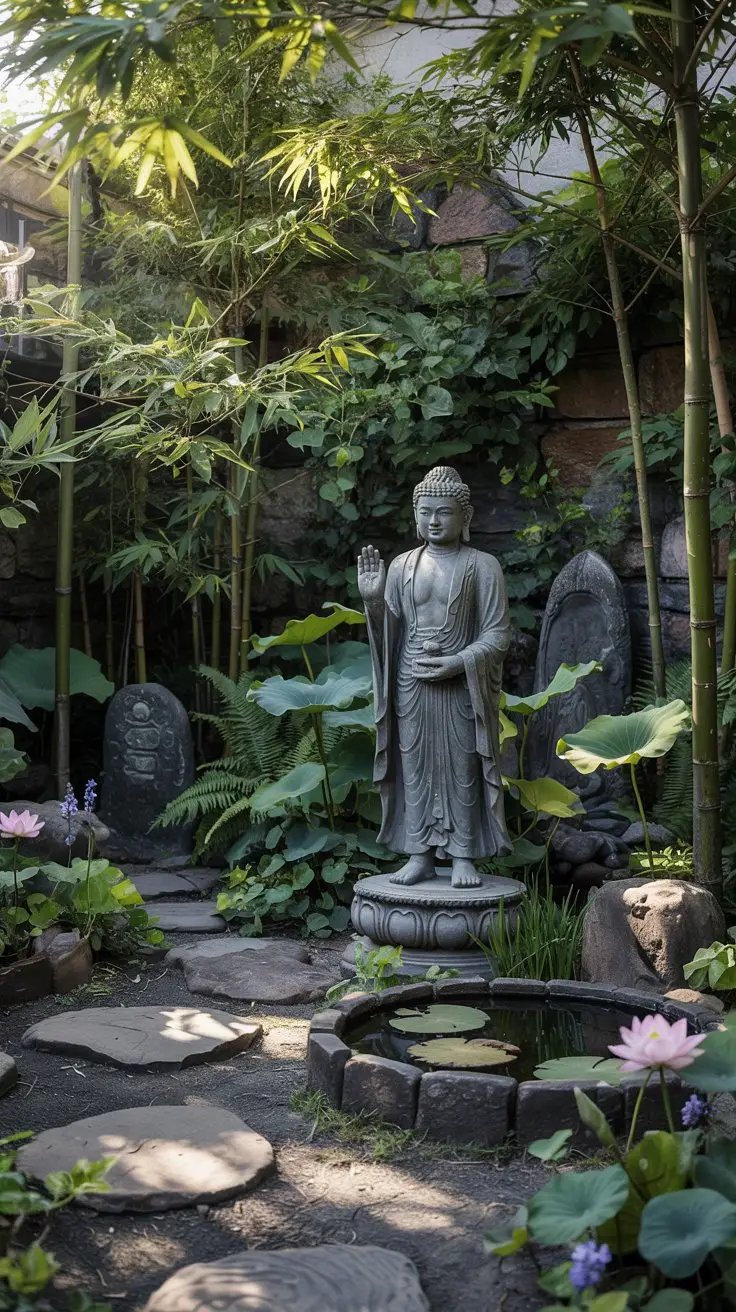
The Buddha Statue (Focal Point)
The Buddha statue is the heart of your garden, symbolizing peace, enlightenment, and compassion. It’s a gentle reminder to pause, breathe, and find calm. But not all statues are the same.
Different mudras—hand gestures—express various meanings:
- Abhaya (fearlessness): The right hand raised, palm outward. A comforting gesture that offers protection.
- Dhyana (meditation): Both hands resting in the lap. Represents deep meditation and inner wisdom.
- Bhumisparsha (earth witness): The right hand touching the earth, symbolizing the moment Buddha achieved enlightenment.
Choosing your statue carefully matters. If your space is small, pick a compact, simple figure that fits naturally. For larger gardens, bigger statues create a strong focal point. Materials like stone or resin offer durability outdoors, while wood is warm but needs more care. Placement matters too—put your statue in a visible yet quiet spot. Arrange plants or stones around it to create a respectful, calming space.
Plants: The Breath of Life
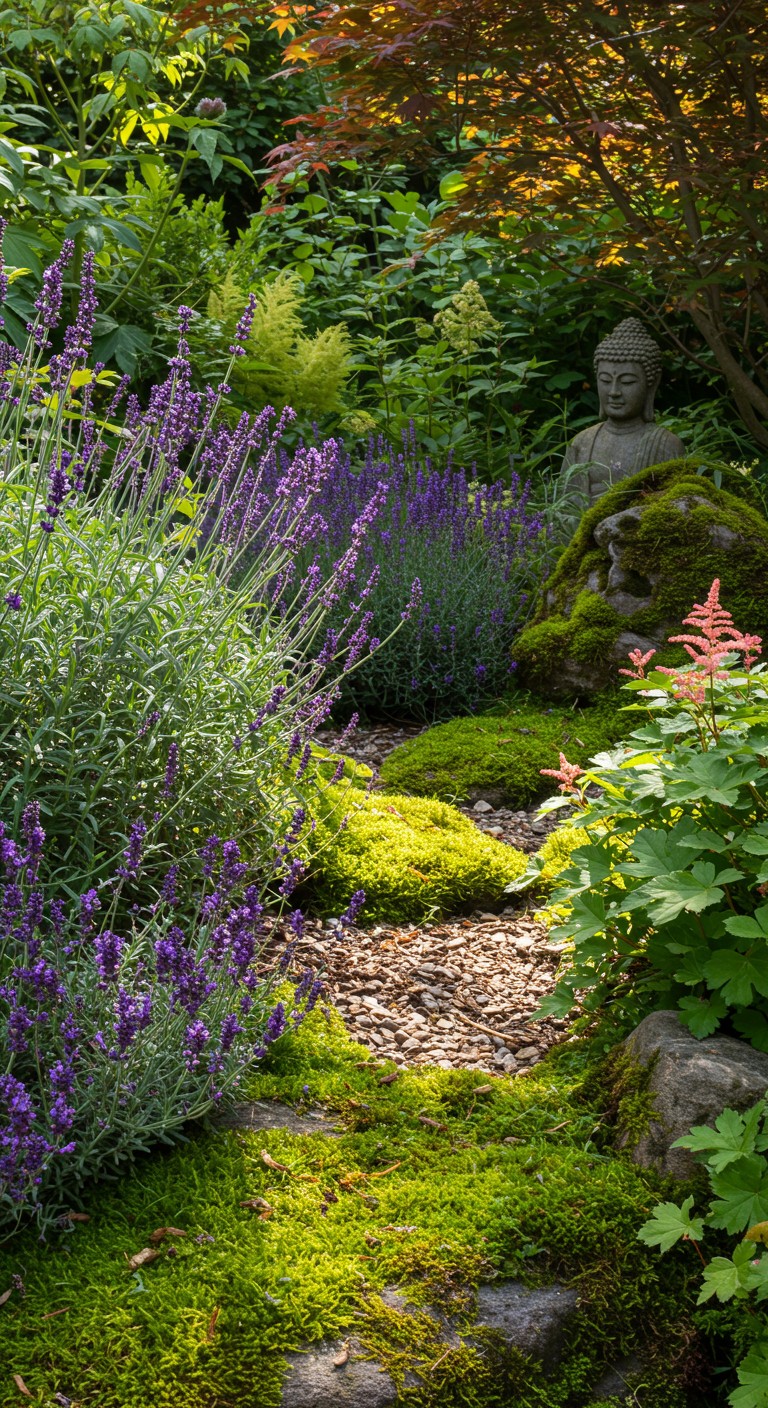
Plants bring softness, color, and life to your Buddha garden. Choose plants that feel calm, resilient, and meaningful. Remember, simpler is better.
Some symbolic plants to consider:
- Lotus: Symbolizes purity and enlightenment. Beautiful floating flowers, perfect if you have water.
- Bamboo: Means resilience and flexibility. It’s fast-growing, creates privacy, and rustles softly in the breeze.
- Bonsai: Represents patience and harmony. Ideal for small spaces, showcasing careful growth over time.
For calming greenery:
- Japanese Maples: Graceful trees with delicate leaves that change colors seasonally.
- Ferns: Soft, lush, and great for shaded areas.
- Ornamental Grasses: They move gently in the breeze, adding soothing sounds and visual interest.
Fragrant plants enhance your garden’s sensory experience:
- Lavender: Sweet-smelling and calming.
- Jasmine: Strong, sweet fragrance that fills the air, especially in the evening.
- Gardenia: Rich, sweet scent and beautiful white flowers.
Don’t forget moss or groundcovers—they create soft, natural carpets, connecting elements smoothly. Plant your garden naturally, letting plants mingle freely rather than strict rows or shapes. This relaxed style keeps your space feeling peaceful and authentic.
Stone and Rock: The Foundation of Stability
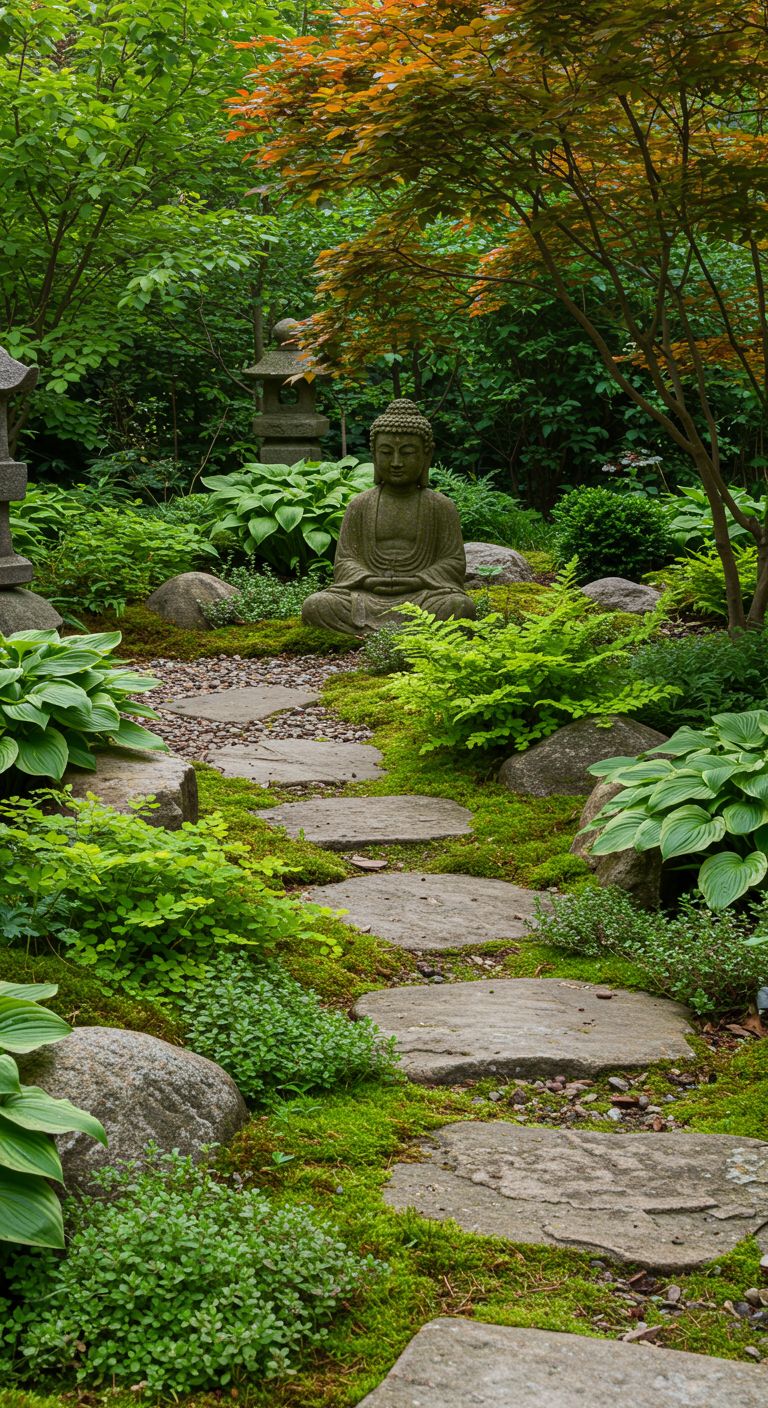
Stones represent permanence, strength, and calm stability. They’re essential for grounding your Buddha garden, making it feel anchored and timeless.
Ideas for stone use include:
- Stepping stones: Create mindful paths to encourage slow, intentional walking.
- Rock groupings: Suggest natural landscapes like mountains or islands, sparking quiet contemplation.
- Individual accent stones: Place single, meaningful rocks around your Buddha statue or among plants.
- Gravel or pebbles: Used creatively, these can subtly mimic the peaceful patterns of Zen gardens.
When placing stones, choose naturally weathered shapes. Smooth, rounded stones feel calm, while larger, rougher rocks create visual interest. Let stones blend into your landscape naturally.
Water: The Flow of Tranquility

Water symbolizes purification, reflection, and life’s constant flow. Even small water elements can dramatically enhance your garden’s sense of calm.
Consider these peaceful water features:
- Small fountains: The gentle sound of flowing water is relaxing and masks unwanted noise.
- Bird baths: Attract birds, bringing life and gentle movement.
- Bowls of water: Simple and elegant, place floating flowers for beauty.
- Small ponds: If space allows, ponds can become serene focal points.
Water sounds matter too. Gentle trickling is calming; loud splashes may disturb quiet reflection. Pick a water feature that matches your space and personal preference.
Natural Elements & Subtle Details
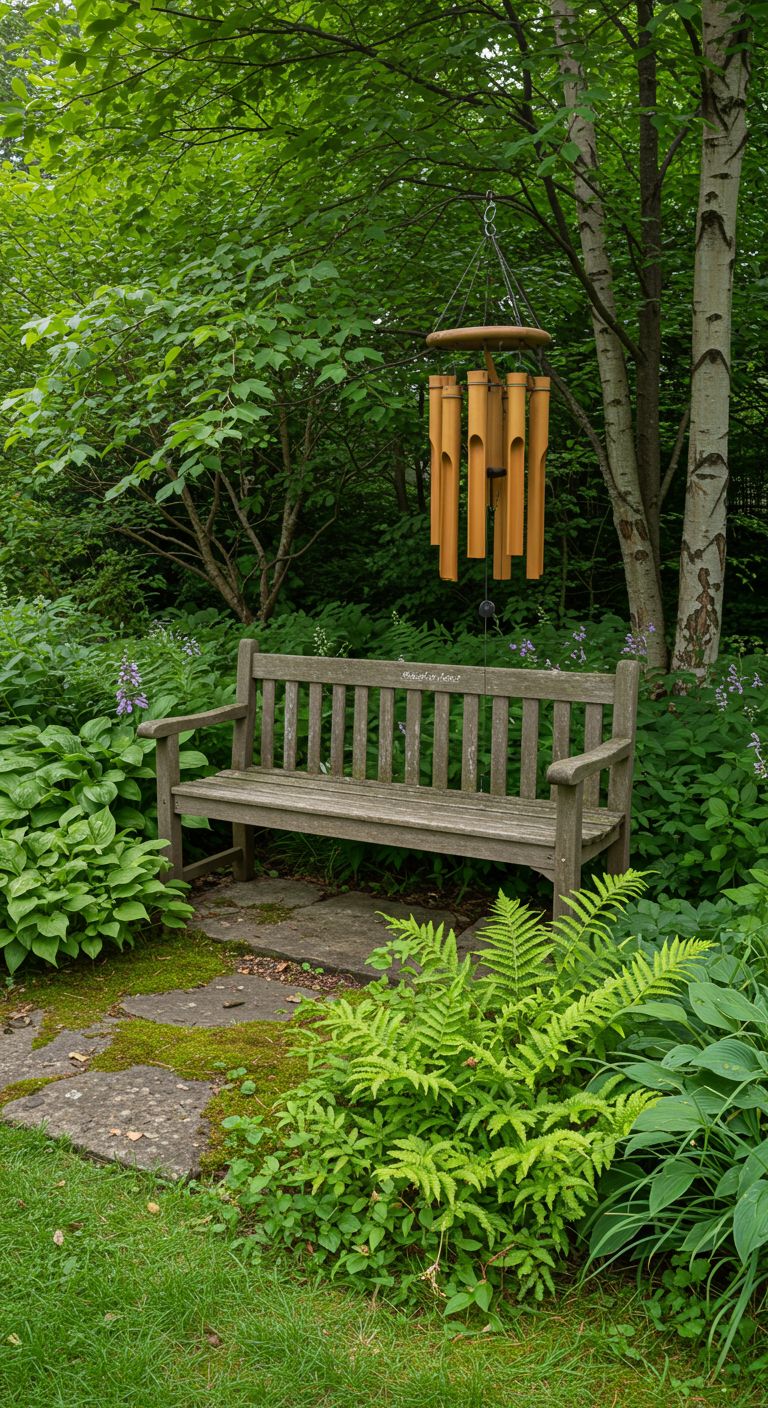
Details make your garden uniquely yours. Thoughtful additions enhance peace and comfort:
- Wood: Use wooden benches or simple bridges to add warmth. Natural edges or rustic finishes fit best.
- Wind chimes: Choose gentle, soft-sounding chimes rather than loud ones, adding subtle music.
- Lanterns: Solar-powered lanterns softly illuminate evenings, extending peaceful moments into nighttime.
- Prayer flags (optional): Add subtle bursts of color and spiritual meaning if they resonate with you.
- Seating: Comfortable benches, cushions, or chairs invite lingering, meditating, or quietly reflecting.
Keep details minimal and thoughtful—each item should enhance the calmness and comfort of your garden.
Creating Your Space: Inspiration for Different Outdoor Areas
No matter the size or location of your space, you can create a calming Buddha garden. Whether you have a spacious backyard or just a sunny corner indoors, here’s how to create tranquility wherever you are.
Idea 1: The Backyard Buddha Garden
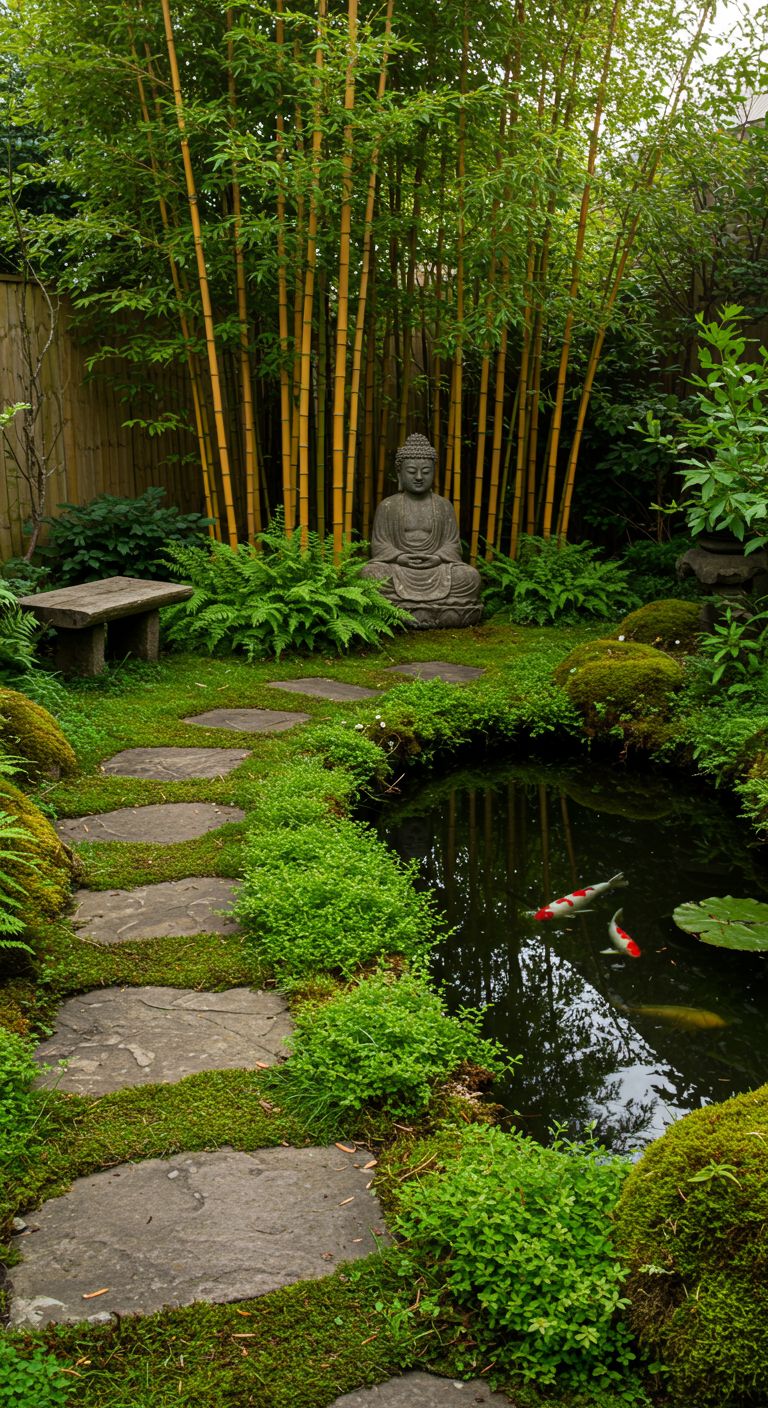
If you have a backyard, you can dedicate a peaceful section to your Buddha garden. Start by choosing a quiet area away from distractions like noisy streets or busy paths.
Create pathways using stepping stones. These guide visitors gently, encouraging mindfulness. You can also divide your garden into different zones—meditation space, plant area, and water feature—to make it feel purposeful.
For larger gardens, consider adding water features like small ponds or fountains. Surround them with rocks and lush plants to boost serenity. Tall bamboo or ornamental grasses make excellent natural screens, giving your garden privacy and a cozy feeling.
Picture this: A lush corner garden with winding stone pathways, a serene Buddha statue surrounded by gentle bamboo, and a small reflective pond that mirrors the calm above.
Idea 2: The Patio or Deck Buddha Garden
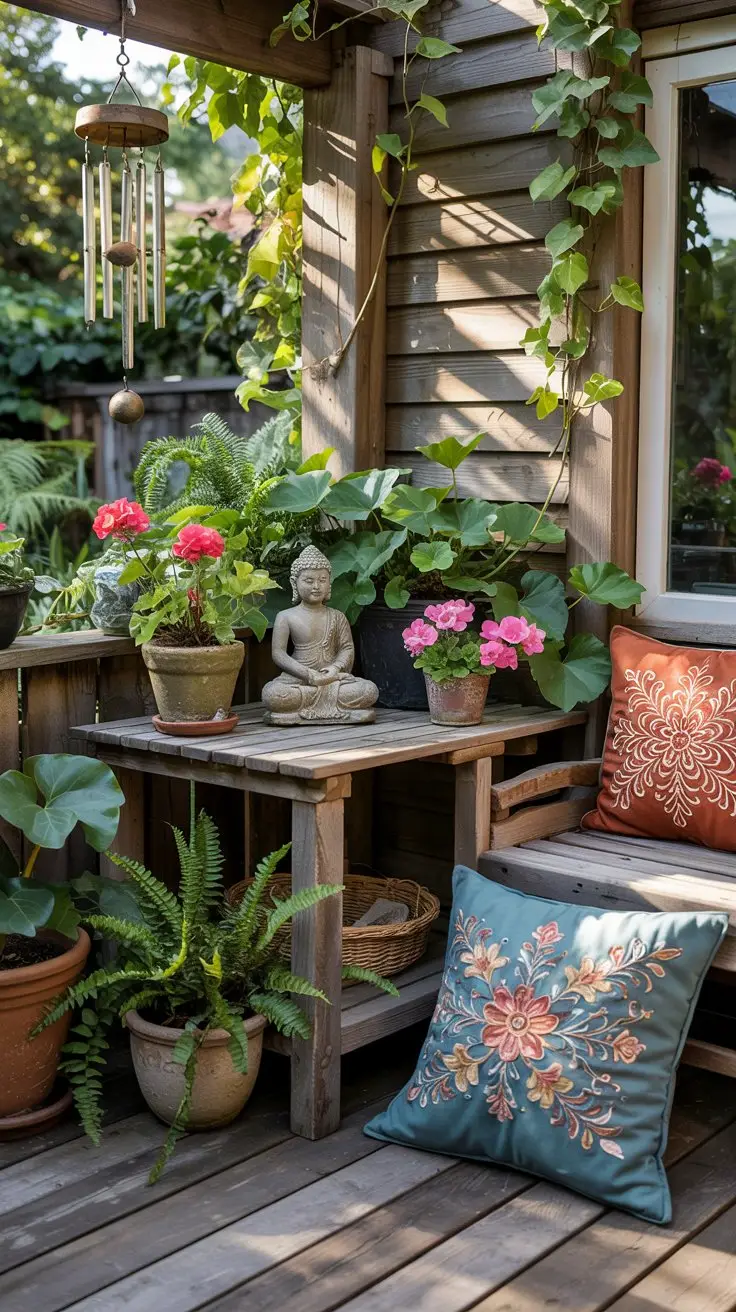
If you have a patio or deck, containers are your best friend. Choose pots of different sizes and shapes, placing them around your Buddha statue to form a natural arrangement.
Vertical elements add visual interest. Install trellises or wall-mounted planters with climbing plants like jasmine or ivy. Small tabletop fountains bring gentle sounds of water without taking up too much space.
Keep decorations simple. Select a smaller Buddha statue made of lightweight resin or stone. Outdoor rugs, cushions, and simple seating help define this peaceful space, making it comfortable and welcoming.
Picture this: A cozy deck corner featuring a compact Buddha statue, softly flowing tabletop fountain, colorful potted plants, and inviting cushions that encourage quiet contemplation.
Idea 3: The Balcony Buddha Nook
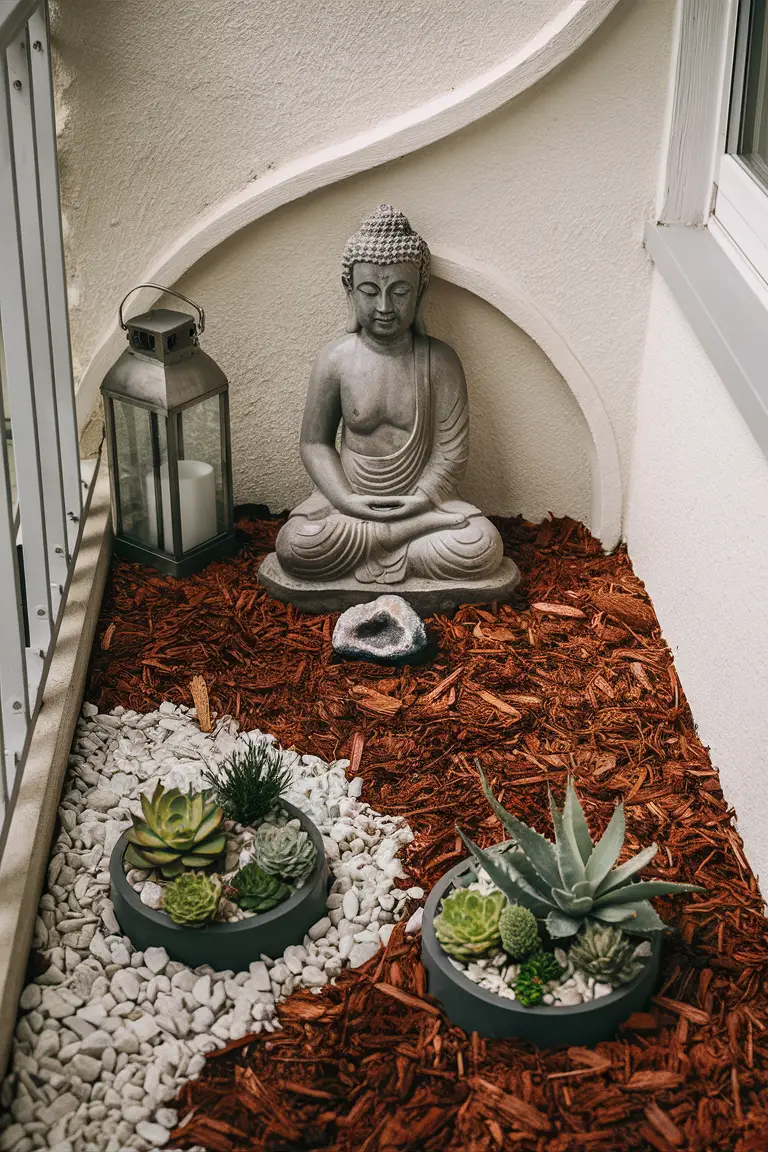
Balconies offer small but meaningful opportunities. Focus on maximizing space through smart arrangements. Wall-mounted shelves and planters keep the floor clear. Choose compact plants like dwarf bamboo or miniature ferns.
Pick a small, lightweight Buddha figurine to avoid cluttering the limited space. Include just one comfortable cushion or stool for meditation. Since balconies get windy, choose hardy, wind-resistant plants like grasses or succulents. Simplicity here creates a powerful sense of calm in a tiny area.
Idea 4: The Corner Buddha Garden
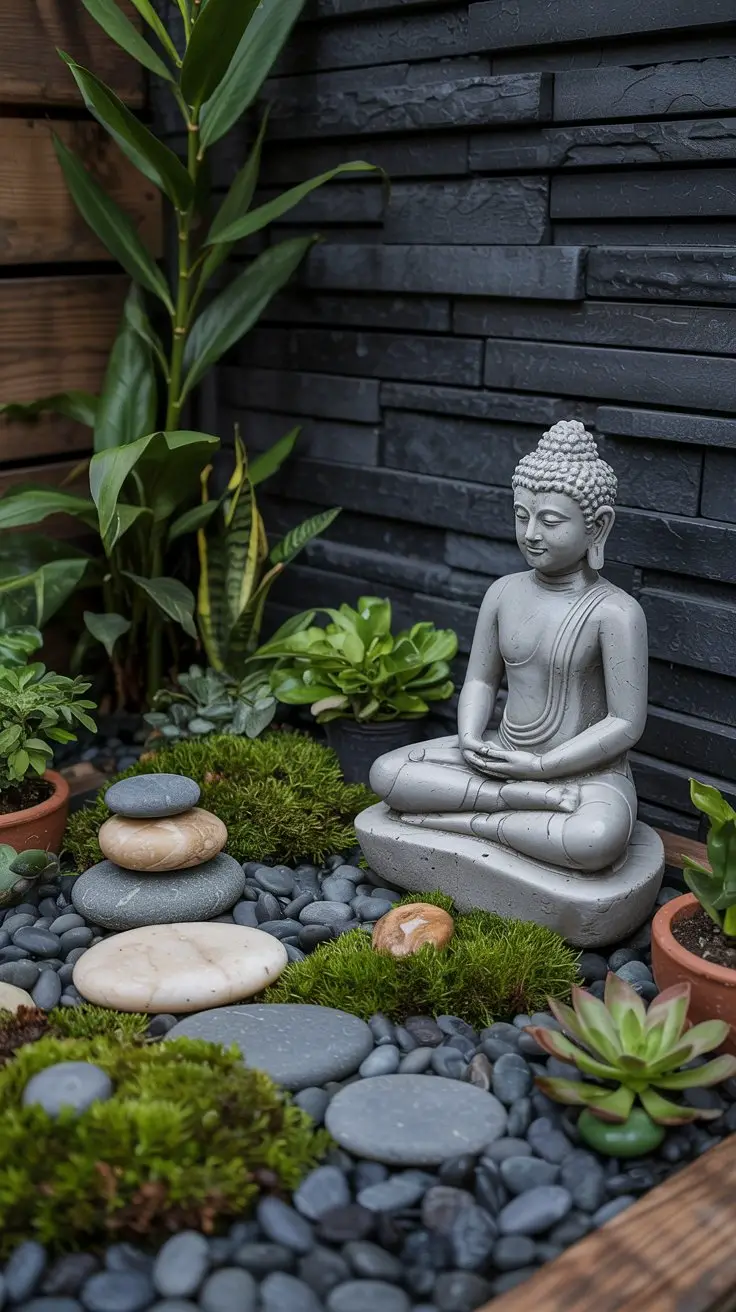
Unused corners, indoors or outdoors, make perfect meditation spots. Define your space clearly. Use low stone walls, wooden fences, or even changes in ground covering to visually separate this area.
Place your Buddha statue strategically in the corner to create a sense of intimacy. Layer elements: taller plants in the back, shorter ones upfront. Add rocks or ground covers for visual depth. Even without physical walls, carefully arranged plants create a secluded feel.
Use existing features like fences or architectural details as part of your design, making it feel naturally integrated into your space.
Picture this: A cozy garden corner with a serene Buddha statue nestled among layered greenery, softly enclosed by plants, creating an inviting sense of privacy and calm.
Idea 5: The Small Buddha Garden
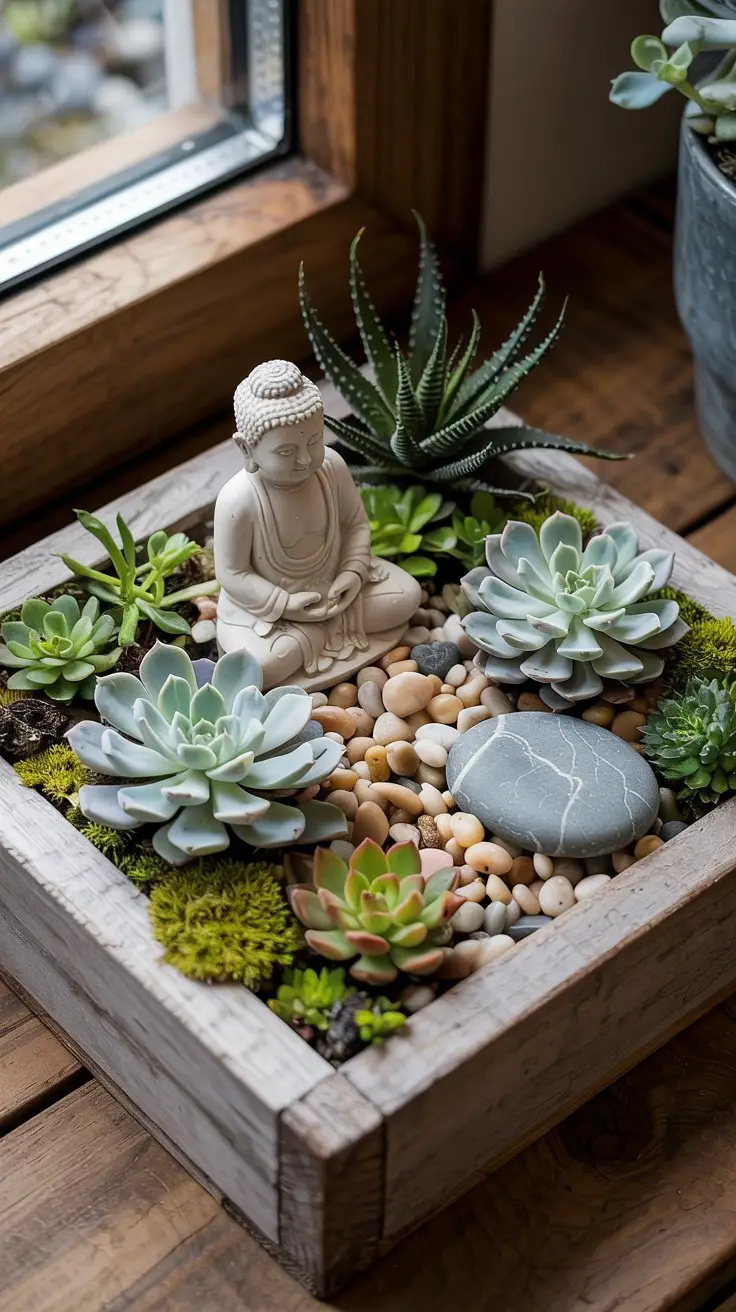
Even very small spaces can become peaceful retreats. A few large containers grouped together or a dedicated window box are enough.
Use miniature landscaping techniques. Tiny Buddha figurines, small succulents, and decorative pebbles create beautiful micro-gardens. Vertical solutions like hanging baskets or narrow shelves save space effectively.
Prioritize sensory details. A single fragrant plant or a tiny solar-powered water feature makes a big impact. Consider portable setups too—a garden in a large attractive pot you can move around as needed.
Idea 6: Indoor/Outdoor Transition
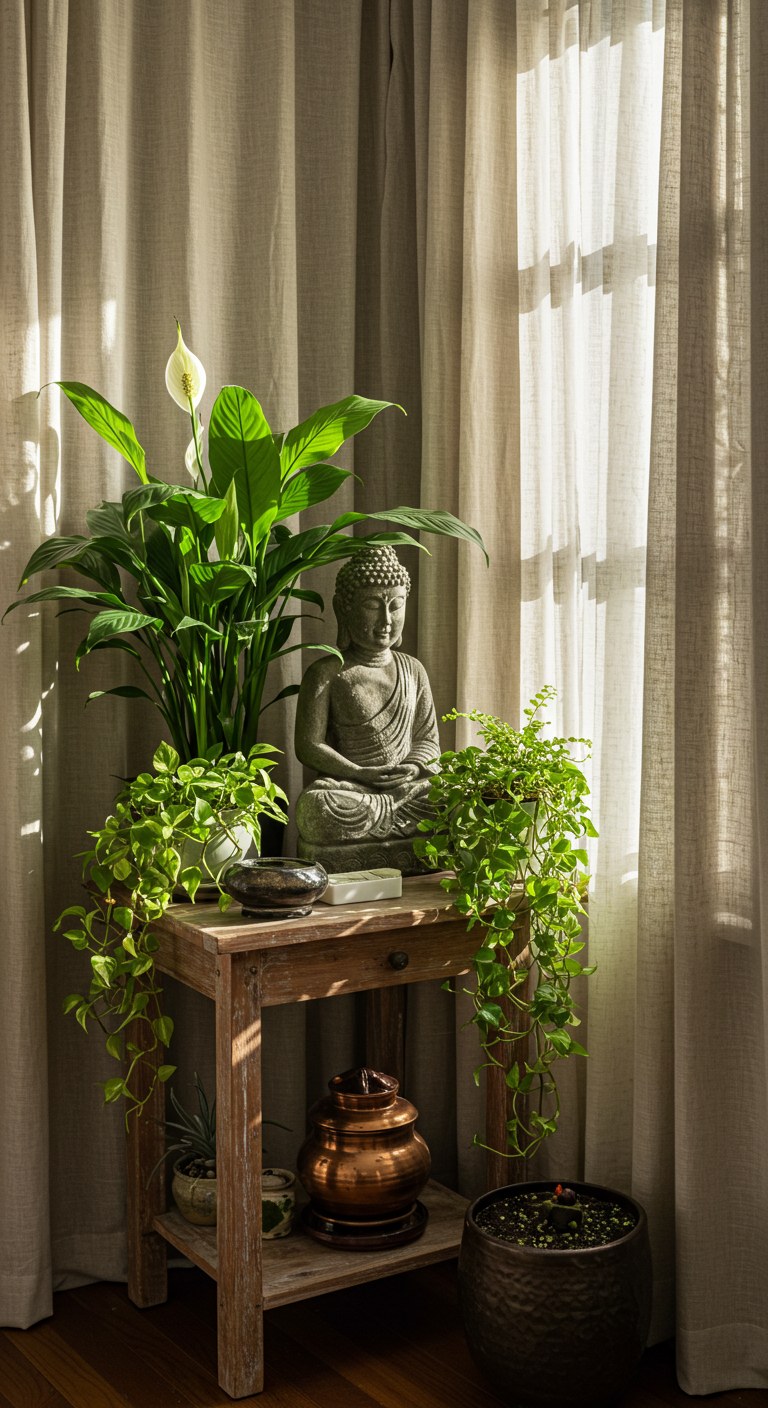
If your space shifts between indoors and outdoors—like a windowsill garden that moves to a balcony—you can still create a Buddha garden.
Choose plants that thrive indoors and outdoors, like succulents or herbs. Small, portable trays with pebbles or miniature water features move easily between spaces. Keep your Buddha statue small enough for easy relocation.
Natural light matters greatly, so position your portable garden where sunlight is consistent. Adjust the plants and layout occasionally to maintain balance and health.
Cultivating the Connection: Maintaining Your Buddha Garden
Creating your Buddha garden is only the beginning. Maintaining it helps build your connection to the space. Caring for your garden becomes a calming practice, making maintenance enjoyable rather than a chore.
Mindful Maintenance
Taking care of your garden can feel like meditation. Move slowly, breathing deeply as you water, trim, and tidy up. Notice small details—the texture of leaves, the sound of water, or the warmth of sunlight. Mindfulness turns garden chores into calming rituals.
Regular Watering and Plant Care
Plants need regular attention to thrive. Water them consistently, adjusting based on weather and plant needs. Feel the soil—if it’s dry, gently water. Keep an eye out for wilted or damaged leaves. Prompt care ensures your garden stays lush, vibrant, and inviting.
Sweeping and Tidying
Simple cleanliness maintains the tranquility of your space. Sweep leaves gently, clear debris from stones or paths, and keep water features clean. A tidy garden invites relaxation and keeps your mind clear.
Pruning and Shaping
Plants naturally change over time. Mindful pruning guides their growth and maintains balance. Remove dead or crowded branches carefully. Shaping plants gently helps maintain your garden’s beauty and encourages healthy growth.
Seasonal Adjustments
Each season brings changes. Adapt your garden to shifting weather and growth patterns. In colder months, protect sensitive plants, and move delicate decorations indoors. In warmer seasons, introduce new plants or elements that suit the climate. Seasonal adjustments keep your garden thriving year-round.
Listening to Your Garden
Pay close attention to what your garden tells you. If a plant struggles, move it. If water features feel overwhelming, simplify them. Your garden communicates clearly through growth and change. Listen carefully and respond thoughtfully, keeping the harmony and balance alive.
The Evolving Nature of the Garden
Accept that your garden will naturally evolve. Plants grow, stones shift, and water patterns change. Welcome this evolution—it reflects life’s natural rhythms. Adjust your garden gradually, honoring its journey and yours.
Finding Peace in Your Creation
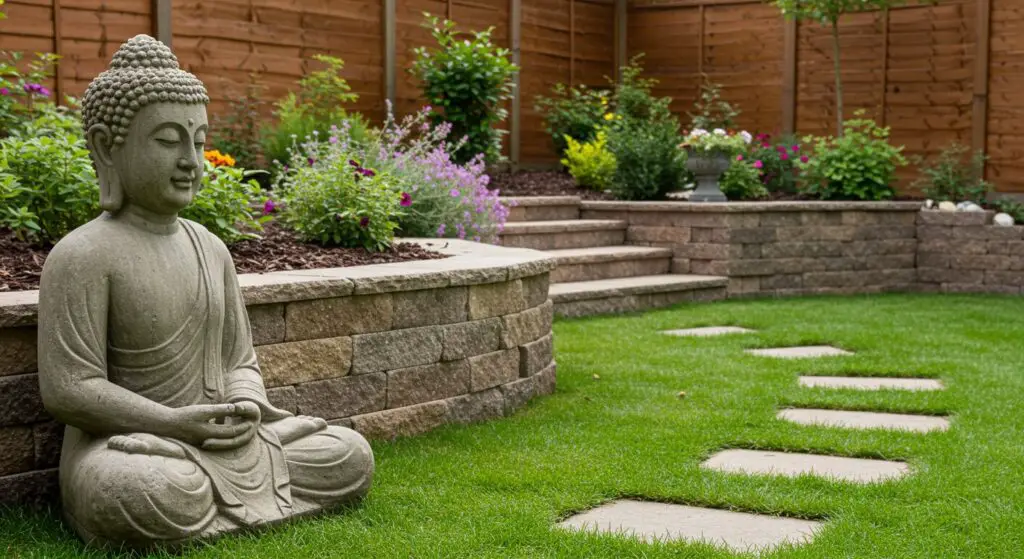
Creating a Buddha garden isn’t just about arranging elements beautifully. It’s about finding inner peace. Every part of your garden—from statue to plant—supports your journey toward mindfulness.
There’s no single correct way to design your garden. Make it uniquely yours, reflecting your tastes, experiences, and hopes. Personal touches deepen your connection, making your garden a true sanctuary.
Spend quiet time in your garden regularly. Sit quietly and breathe deeply. Practice simple meditation, or just watch nature unfold. Allow your garden to inspire mindfulness and presence, reminding you to appreciate each moment.
Your garden holds endless possibilities. Over time, as you nurture and adapt it, you’ll discover new depths of calm. The peace you’ve created is always there, inviting you back again and again.
Picture this: A peaceful figure quietly meditating in a serene garden, surrounded by gentle plants and calming elements, reflecting deep inner peace and mindfulness.
Final Thoughts
Creating a tranquil Buddha garden doesn’t require grand spaces or complex designs. Even the smallest corner can become a sanctuary of peace, mindfulness, and personal meaning. Through thoughtful arrangement of statues, plants, water, stones, and mindful details, your garden becomes an everyday retreat.
Start small, but start now. Choose meaningful elements, arrange them with care, and nurture your garden mindfully. Soon, you’ll find your own whispers of wisdom, right outside your door.


